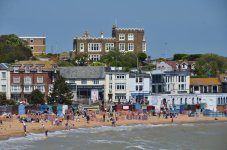Sorry, I missed that you were using Sunny 16 with Manual camera mode. Sunny 16 certainly can be ballpark correct, but a couple of things should be noted.
Sunny 16 was used very many years ago, before electronics and light meters. It was all we had back then, and it was great then, and such instructions were packaged with every roll of film. We used Negative film then. Negative film has much more exposure latitude than slides or digital positives, so it mattered much less. Because, it was normally easy to correct negative film exposure in the dark room, so we never realized the exposures were not precisely accurate. The photo-finisher guy took care of it for us. Slides and digital positives are much more critical than negative film, we have to use the actual result.
Sunny 16 works sort of in full stops, from bright sun to hazy or slightly cloudy, to cloudy, to overcast, etc. This involves decisions. The main trick is to learn to judge the density of the shadows cast, much easy to judge the shadows than the light. Pay full attention to the shadows cast.
Wikipedia:
| Aperture | Lighting Conditions | Shadow Detail |
|---|
| f/22 | Snow/Sand | Dark with sharp edges |
| f/16 | Sunny | Distinct |
| f/11 | Slight Overcast | Soft around edges |
| f/8 | Overcast | Barely visible |
| f/5.6 | Heavy Overcast | No shadows |
| f/4 | Open Shade/Sunset | No shadows |
Sunny 16 is a still great thing to know, as a check for reasonableness about what our stupid light meter is doing.

But technology improved, and then we invented light meters, which easily have third stop resolution. Plus, the meter literally measures the light actually present. There is much to be said for light meters (but there is a skill involved in using them).
However, the camera meter is a Reflected meter. It does not see the Incident light, it is not measuring "the light". The Reflected camera meter only sees the light reflected from the subject, which is not very much reflected from dark subjects, and a lot more reflected from more reflective subjects, etc. (a black dress or white dress for example, gives very different readings, neither of which is actually correct for exposure). If we meter on the black dress, it comes out middle gray. If we meter on the white dress, it comes out middle gray. But instead, we want it the original shade, either black or white. So, we have to think about what we are doing.
So there is still thinking involved with determining exposure by metering.
How light meters work
